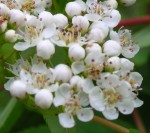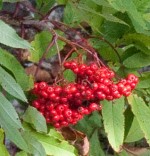 American mountain ash is a small deciduous tree or large shrub native to northeastern North America from Newfoundland to Manitoba, south to Maryland, Illinois, and Minnesota and in the mountains to Georgia where it grows in open woods, rocky slopes, and outcroppings. It is a member of the rose family Rosaceae, that also includes cherries, hawthorns, and blackberries, and is not related to the true ash , Fraxinus. The trunks have smooth gray bark when young before developing splits cracks and scales that eventually peel off. The pinnately compound leaves are six to ten inches long with eleven to seventeen narrow leaflets two to three inches long. They are dark yellow green above, lighter below, and turn yellow, orange, red or purple in the fall. In late spring to early summer small creamy- white flowers 1/8 inch across appear in flat clusters three to five inches in diameter at the tips of one year old branches. The clusters of bright red berry-like fruit that are eaten by birds and small mammals, and can be made in to jelly. Moose and deer eat the twigs, foliage and bark. In northern climates, American mountain ash is a good choice for a specimen or shade tree and can be used as a street tree. A cultivar ‘Dwarfcrown’ is available. The generic name, Sorbus , is the Latin name for service tree. The specific epithet americana refers to the geographic origin of the tree.
American mountain ash is a small deciduous tree or large shrub native to northeastern North America from Newfoundland to Manitoba, south to Maryland, Illinois, and Minnesota and in the mountains to Georgia where it grows in open woods, rocky slopes, and outcroppings. It is a member of the rose family Rosaceae, that also includes cherries, hawthorns, and blackberries, and is not related to the true ash , Fraxinus. The trunks have smooth gray bark when young before developing splits cracks and scales that eventually peel off. The pinnately compound leaves are six to ten inches long with eleven to seventeen narrow leaflets two to three inches long. They are dark yellow green above, lighter below, and turn yellow, orange, red or purple in the fall. In late spring to early summer small creamy- white flowers 1/8 inch across appear in flat clusters three to five inches in diameter at the tips of one year old branches. The clusters of bright red berry-like fruit that are eaten by birds and small mammals, and can be made in to jelly. Moose and deer eat the twigs, foliage and bark. In northern climates, American mountain ash is a good choice for a specimen or shade tree and can be used as a street tree. A cultivar ‘Dwarfcrown’ is available. The generic name, Sorbus , is the Latin name for service tree. The specific epithet americana refers to the geographic origin of the tree.
 Type: Deciduous tree
Type: Deciduous tree
Outstanding Feature: Flowers, berries
Form: Rounded crown
Growth Rate: Slow
Bloom: Small creamy- white flowers 1/8 inch across in flat clusters three to five inches in diameter at the tips of one year old branches in late spring to early summer
Size: 15-40’ h x 10-30’ W
Light: Full sun
Soil: Average, moderately moist, well-drained, acidic
Hardiness: Zones 3-6
Care: Prune from late fall to early spring if needed.
Pests and Diseases: Fireblight, scab, cankers, crown gall, powdery mildew, rust, borers, aphids, sawfly, and scale
Propagation: Seed